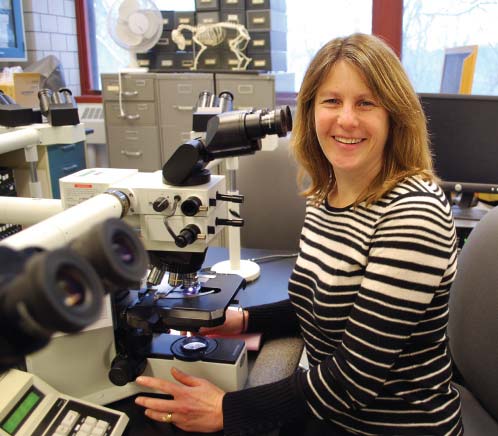Clinical pathology bridges animals and answers
 “Blood is the window to the body,” says Dr. Tracy Stokol, a professor with a passion for pathology puzzles. Microscopic magnification opens that window, revealing a cellular world which veterinarians explore in the quest to analyze disease. Clinical pathologists like Stokol navigate that world as diagnostic detectives, using cellular samples from body tissue and fluids to piece together a patient’s story.
“Blood is the window to the body,” says Dr. Tracy Stokol, a professor with a passion for pathology puzzles. Microscopic magnification opens that window, revealing a cellular world which veterinarians explore in the quest to analyze disease. Clinical pathologists like Stokol navigate that world as diagnostic detectives, using cellular samples from body tissue and fluids to piece together a patient’s story.
If an animal has a bodily bump, how do you tell if it’s a bruise or inflammation, a fatty tumor or malignant cancer? Veterinarians use needles to take samples for examination. Clinical pathologists use these cellular clues to solve medical mysteries.
“It’s critical for veterinarians to know clinical pathology because they use it every single day,” says Stokol. “Sick animals can’t tell you what’s wrong. Samples speak for the animals and clinical pathology translates. It’s a bridge between the animal and the answer.”
Body fluids can reveal much of what goes on inside an animal’s body. “Blood can tell you why a joint is swelling, expose cancer cells, or show abnormalities that indicate underlying liver disease,” illustrates Stokol. “We also work with bone marrow aspirates, samples from lymph nodes, cerebrospinal fluids, anything you can put a needle into and take a sample of could give an important clue.”
Stokol has taught the visual language of cellular samples at the College of Veterinary Medicine since 1993, and is now an associate professor in the Department of Population Medicine and Diagnostic Sciences. A skilled specialist, Stokol attributes her passion for clinical pathology to the fun of solving a mystery.
“I like a challenge,” says Stokol with steady eyes that have faced plenty of challenge in the microscopic realm. “I’m always intrigued by difficult cases and love figuring things out. Clinical pathology is a very visual field. You’re seeing interesting changes that are visually fascinating. It’s fun to look at things, but it’s also about putting pieces of information together to make a story.”
Stokol’s story started in Melbourne, Australia, where she earned her veterinary degree in 1987, worked for two years as an assistant veterinarian, and earned a PhD before coming to Cornell. She belongs to several societies for clinical pathology, chemistry, and diagnostics, and has published several book chapters and over 50 papers in peer-reviewed journals, reflecting her dedication to furthering research in her field.
“Research stimulates a kind of intellectualism you don’t get from puzzling out a case. It’s an entirely different way of thinking,” explains Stokol. “A lot of what we do in clinical work is memorizing facts and recognizing patterns. Research lets you ask more kinds of questions, it makes you think ahead and plan, and learn to deal with things that don’t work out the first time.”
That’s why Stokol and her colleagues require that the College’s clinical pathology residents complete a research project.
“Working in an academic environment, we need to advance the knowledge of our field. We have to continue to grow and understand more about the diseases we’re working with and the only way to do that is through research.”
As an academic clinician, Stokol furthers her passion through her teaching. Together with fellow clinical pathologists Dr. Heather Priest and Dr. Diana Schaefer, Stokol supervises the College’s residency program in clinical pathology.
“We need academic clinical pathologists to keep advancing the field and to keep it alive. Fewer people go into clinical pathology because there are fewer residencies available. We’re graduating fewer people, so fewer people are trained.”
Specialists in this field need thorough training to learn to successfully sort out the secrets cells can tell. But for Stokol and her peers, the challenge is worth it.
“One of the job’s biggest appeals is the instant gratification, knowing that you’re making a difference,” Stokol says. “Clinical pathology gets rapid results that help animals and their owners almost immediately. You’re giving vital information that a veterinarian can use to decide how to manage or treat a patient, or helping an owner make a decision about whether to continue a treatment. We can make a diagnosis and know we’re having a real effect.”
“I like that I can do everything with clinical pathology at Cornell,” says Stokol. “Service helps patients in real-time, research expands our knowledge, teaching ensures the future. It’s the best of all worlds.”